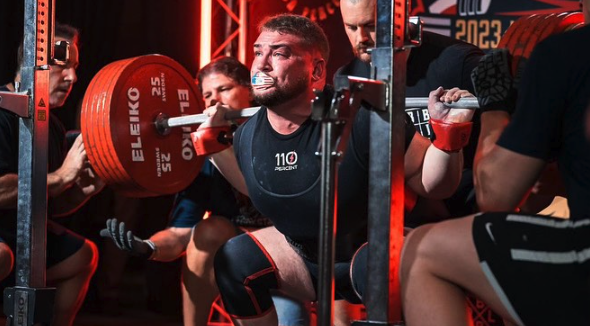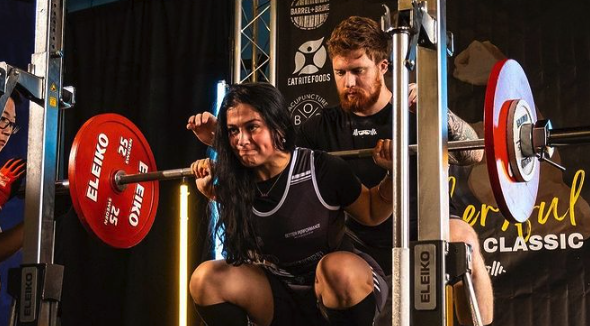Does Powerlifting Build Muscle? A Comprehensive Guide
Written by The Boostcamp Editors
Does Powerlifting Build Muscle? The Ultimate Guide
Are you struggling to gain muscle despite putting in hours at the gym, eating right, and getting the proper amount of recovery? Have you considered using powerlifting as a training method for serious muscle building? Powerlifting is more than just lifting heavy weights on the platform; it is a strength sport that involves three main compound lifts: squat, the bench press, and deadlift. The goal is to get as strong as possible on these compound lifts, hitting a crazy one rep max, which is not a training style or goal that you typically see when it comes to building muscle mass. Instead you see people aiming to build muscle mass (like bodybuilders) aiming for more volume and intensity during their training sessions. But, can powerlifting build muscle?
In this post, our team at Boostcamp will dive into the science behind how powerlifting can help build more muscle. We'll explore key exercises and training strategies, including balancing load and volume, rest period optimization, and nutrition. We'll also take a closer look at real-life examples of successful powerlifters who have built impressive physiques through this sport. So if you're looking to maximize your muscle gain potential, read on for tips on how to use powerlifting as an effective tool in your fitness journey.
Understanding Powerlifting

Powerlifting, a strength sport that focuses on the three main compound lifts - bench press, squat, and deadlift. Competitions in powerlifting are based on the maximum weight lifted in each lift. This sport requires a combination of strength, technique, and mental focus. Powerlifting emphasizes lifting heavy weights for low reps, which in turn can help increase muscle mass and overall strength. It is a form of resistance training that targets major muscles and offers numerous health benefits. Powerlifting is a great addition to any fitness routine, with benefits including improved bone density and insulin sensitivity.
Rules of Powerlifting
Powerlifting gives the lifter three attempts at each lift: squat, bench press, and deadlift. The competitions are governed by strict rules and regulations laid out by the organization to ensure fairness for each competitor. Powerlifters compete in different weight classes, allowing for equal competition amongst lifters of similar size and weight. To maximize performance and prevent injuries, proper form and technique are essential in powerlifting. Progressive overload is a key aspect of powerlifting training, constantly challenging the muscles to adapt and grow. Incorporating these basics into your fitness routine can lead to increased muscle mass, strength, and various health benefits.
Powerlifting Vs. Other Strength Sports
Powerlifting and other strength sports like Olympic Weightlifting have distinct differences. While powerlifting focuses on pure strength, other strength sports may prioritize different aspects such as speed or endurance. Powerlifting competitions are based on maximum weight lifted for one singular repetition, unlike other strength sports that may involve timed events or specific movements, such as things like strongman or CrossFit. In powerlifting training, lower rep ranges and heavier weights are typically used compared to other strength sports. Additionally, powerlifting has its own set of rules and regulations that differ from other strength sports. Specialized equipment, like powerlifting belts and supportive gear, is required in powerlifting.
The Science Behind Building Muscle in Powerlifting
Strength training is an essential factor in building muscle, and powerlifting offers an effective way to achieve this. By following the principle of progressive overload, powerlifting promotes muscle growth. The different powerlifting exercises target multiple muscle groups, leading to overall muscle development. Additionally, powerlifting training stimulates muscle hypertrophy by recruiting fast-twitch muscle fibers. Furthermore, powerlifting workouts create metabolic stress, which contributes to muscle growth. Incorporating powerlifting into your fitness routine can result in bigger muscles and numerous health benefits.
Role of Strength Training in Muscle Building
Strength training plays a vital role in muscle building. It stimulates muscle protein synthesis, which leads to muscle growth. By increasing muscle fiber size and improving muscle strength, strength training helps in enhancing muscle density and definition. Moreover, strength training promotes an increase in muscle mass and overall body composition. It also boosts metabolism, aiding in fat loss while facilitating muscle gain. Incorporating resistance training, such as powerlifting, into your fitness routine can provide numerous health benefits and help you achieve your goal of building bigger muscles.
How Powerlifting Contributes to Muscle Hypertrophy

Powerlifting, with exercises like squats and deadlifts, not only targets multiple muscle groups but also promotes overall muscle hypertrophy. By incorporating high-intensity and heavy-weight lifting, powerlifting provides the necessary stimulus for muscle growth. Additionally, powerlifting increases training volume, a crucial component for muscle hypertrophy. With a focus on compound exercises that engage multiple muscle groups simultaneously, powerlifting efficiently stimulates muscle development. Furthermore, sufficient rest periods during powerlifting training allow for adequate muscle recovery and growth. Incorporating powerlifting into your fitness routine can be a great way to achieve bigger muscles and reap the health benefits of resistance training.
The Top Powerlifting Exercises for Muscle Gain
Powerlifting exercises are highly effective for muscle gain. Squats target the quads, hamstrings, and glutes while bench press primarily works the chest, shoulders, and triceps. Deadlifts engage multiple muscle groups including the back, the glutes, and the hamstrings. Overhead press targets the shoulders and triceps, and rows complement the main powerlifting movements. By incorporating these exercises into your routine, you can achieve significant muscle development. Each exercise focuses on different muscle groups, allowing for well-rounded strength and hypertrophy. Powerlifting provides a comprehensive approach to building muscle and strength.
Key Powerlifting Movements
In powerlifting, key movements are essential for building muscle. Squats target the quadriceps, hamstrings, and glutes, while the bench press focuses on the chest, shoulders, and triceps. Deadlifts engage the back, glutes, hamstrings, and even the core, while the overhead press primarily targets the shoulders and triceps. Rows help strengthen the upper back, biceps, and rear delts. Incorporating these movements into your fitness routine can provide numerous health benefits, such as improved bone density and increased muscle mass. By giving special attention to these exercises, you can achieve your goal of building bigger muscles.
Accessory Exercises for Enhanced Muscle Development
If you're looking to enhance your muscle development, incorporating accessory exercises into your powerlifting routine can be highly beneficial. Lunges target the quads and glutes, while pull-ups engage the back, biceps, and shoulders. Dips primarily work the chest, triceps, and shoulders. Romanian deadlifts focus on the hamstrings, glutes, and lower back, while calf raises strengthen the calf muscles for improved lower body stability. By including these exercises alongside your main powerlifting movements, you can target specific muscle groups and achieve greater overall muscle development.
Training Strategies for Muscle Growth in Powerlifting
To maximize muscle growth in powerlifting, several training strategies can be employed. Progressive overload is crucial, continually increasing weight or reps to challenge the muscles and stimulate growth. Variation is also important, incorporating different exercises and rep ranges to target different muscle fibers and prevent plateaus. Periodization helps optimize muscle growth and prevent overtraining by structuring training into phases. Proper nutrition, including adequate protein and calories, supports muscle growth and recovery. Sufficient rest and recovery are essential, allowing the muscles time to repair and grow between workouts.
Balancing Load and Volume
Varying rep ranges and lifting heavier weights are effective strategies for promoting muscle growth. Powerlifting, with its focus on compound exercises, targets multiple muscle groups simultaneously, leading to overall muscle development. Adequate rest periods between sets allow for muscle recovery and optimal performance during workouts. It is important to gradually increase training volume to avoid overtraining and ensure consistent progress. Manipulating rep ranges and weight in your powerlifting routine can further contribute to hypertrophy, resulting in bigger, stronger muscles.
Rest Periods
Proper rest intervals play a crucial role in muscle development. Longer rest periods allow for greater muscle recovery, giving your body the time it needs to repair and grow. On the other hand, shorter rest periods increase metabolic stress, promoting muscle growth. It's important to tailor your rest periods to your individual goals and training intensity. By finding the right balance, you can maintain performance, reduce the risk of injury, and give your muscles the adequate rest they need to adapt and grow. Remember, rest is just as important as the workout itself.
Nutrition for Powerlifters to Build Muscle
Diet is highly important for building muscle through powerlifting. Consuming adequate protein supports muscle repair and growth, while carbohydrates provide energy for intense powerlifting workouts. Healthy fats aid in hormone production and overall health, and proper hydration is essential for muscle function and recovery. To optimize muscle building potential, it's crucial to have a balanced macronutrient intake. Powerlifters should pay special attention to their nutrition, fueling their bodies with the right nutrients to support their training goals. By focusing on proper nutrition, powerlifters can maximize their muscle building potential and enhance their overall performance.
Importance of Macronutrients in Muscle Building
To maximize muscle building in powerlifting, it's crucial to pay attention to macronutrients. Protein plays a vital role in muscle repair and growth, while carbohydrates provide the necessary energy for intense training sessions. Fats are important for hormone production and overall health. By ensuring an adequate intake of all three macronutrients and optimizing their ratios, you can support your muscle building goals and enhance muscle development. Remember, proper nutrition is just as important as your training regimen.
Calorie Requirements for Powerlifters
Meeting the calorie requirements is crucial for powerlifters who aim to build muscle and develop strength. Individual calorie needs vary based on factors such as body weight, activity level, and specific goals. To ensure sufficient energy for training and recovery, tracking calorie intake is recommended. It's important to maintain a caloric surplus to promote optimal muscle growth. Consistently meeting these calorie requirements supports the overall muscle building goals of powerlifters.
Can You Expect to Gain Size as Well as Strength in Powerlifting?
Powerlifting training is not just about building strength; it also promotes muscle size. With proper programming, nutrition, and focus on progressive overload, powerlifters can maximize their muscle growth. Many powerlifters have impressive physiques due to muscle hypertrophy. Combining powerlifting with hypertrophy-focused training can further enhance muscle development.
Real-life Examples of Muscle Gain through Powerlifting
Real-life powerlifting success stories showcase the impressive muscle gains achievable through this form of resistance training. Many notable powerlifters have developed muscular physiques that demonstrate the potential for size gains in powerlifting. The training methods employed in powerlifting, such as heavy weightlifting and low rep-max sets, contribute to muscle hypertrophy. These adaptations from powerlifting training result in noticeable muscle development and can be a valuable tool for individuals looking to build bigger muscles. By incorporating powerlifting into their fitness routine, lifters can experience not only significant strength gains but also remarkable muscle growth.
Successful Powerlifters who Built Impressive Physique
Numerous powerlifters have achieved remarkable physiques through their training, serving as inspiration for others. These individuals have successfully combined powerlifting with bodybuilding, showcasing the potential for significant muscle gain in the sport. Their achievements highlight the effectiveness of powerlifting in building an aesthetic physique. From increased muscle hypertrophy to improved strength and size, powerlifting offers a unique approach to muscle development. Real-life success stories of powerlifters who have transformed their bodies inspire and motivate others to pursue powerlifting as a means to build muscle and achieve their fitness goals.
Tips on Using Powerlifting to Build Muscle
Incorporating accessory exercises is crucial for targeting specific muscle groups and promoting overall muscle development. It is also important to include hypertrophy-focused training alongside powerlifting movements to optimize muscle growth. Manipulating rep ranges and varying training intensity can further enhance muscle development. Prioritizing proper form and technique is essential to avoid injuries and maximize muscle gains. Implementing periodization techniques allows for a balance between strength and size goals in powerlifting. By following these tips, powerlifters can effectively use powerlifting as a muscle-building tool.
Tracking Training Volume for Optimal Growth
To optimize muscle growth in powerlifting, it is essential to track training volume. Keeping a training log allows for the monitoring of sets, reps, and weights used in each session. Progressive overload, a key principle in powerlifting, can be achieved by gradually increasing training volume over time. Monitoring overall training volume helps prevent overtraining and ensures adequate recovery. Individual goals and progress should dictate adjustments to training volume. By tracking training volume, patterns can be identified and muscle building potential can be optimized.
Incorporating Variety in Your Powerlifting Routine
Incorporating variety in your powerlifting routine can be a game-changer when it comes to building muscle. By varying your exercises and rep ranges, you keep your muscles guessing, which promotes muscle growth. Try adding accessory work to your routine to strengthen weaker muscle groups and improve overall symmetry. Additionally, experimenting with different training techniques like drop sets or supersets can challenge your muscles in new ways and stimulate muscle growth. Periodically changing your training volume and intensity is also important to prevent plateauing and promote continuous muscle gains.
Finding Powerlifting Programs
When looking for a program to powerlift and increase muscle gain, keep in mind that there are plenty of good programs available on Boostcamp to help you make progress. A good program will keep you on track, making sure that you are making the most gains and maximizing your time in the gym. If you are looking to stay on track and continue with linear progression, then finding a good workout program is the key, and with a workout tracker it is even easier. Where do you look for a good workout program? Check out the Boostcamp App for some great programs.
Boostcamp is home to over 50 FREE workout programs that consist of strength, hypertrophy, or functional fitness, or both, from the push pull legs program all the way to upper lower, there are so many programs to choose from that can help fit your needs. However, with Boostcamp, you don’t have to just follow a pre-written program (although each program is written by a professional), you also can create your own program as well, and track your progress to make sure you are on the right track. That being said, when you are looking to incorporate some serious training to further your progress on your bench press by bodyweight, then check out Boostcamp.
Final Thoughts on Maximizing Muscle Gain Through Powerlifting
Building muscle through powerlifting requires consistency, dedication, and proper form. The heavy weights and low reps used in powerlifting can be effective for muscle growth. It is essential to fuel your body with proper nutrition to support muscle recovery and growth. Compound exercises like the bench press, deadlift, and squat should be incorporated into your powerlifting routine as they target multiple muscle groups. Prioritizing rest and recovery allows your muscles to repair and grow after intense powerlifting sessions.
Conclusion
In conclusion, powerlifting is not just about gaining strength; it is also an effective tool for building muscle. By understanding the basics of powerlifting and its benefits for muscle hypertrophy, you can incorporate powerlifting exercises into your workout routine. Balancing load and volume, paying attention to rest periods, and following a proper nutrition plan are key strategies for maximizing muscle growth in powerlifting. Real-life examples show how powerlifting can help you achieve an impressive physique while gaining size and strength. So, if you're looking to build more muscle, consider incorporating powerlifting into your fitness journey. Remember, consistency and proper technique are crucial for success. Start your powerlifting journey today and watch your muscles grow stronger and bigger.
Be sure to follow Boostcamp on Instagram and subscribe on YouTube!

All images courtesy of Instagram (@usapowerlifting)

